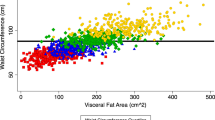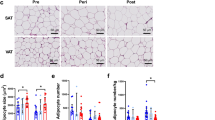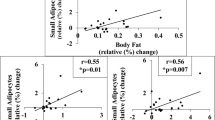Abstract
Objectives:
The purpose of this analysis was to evaluate sex differences in the rate of visceral adipose tissue (VAT) and subcutaneous adipose tissue (SAT) accrual in adults. Secondary analyses examined differences in the rate of VAT and SAT accrual in premenopausal, perimenopausal and postmenopausal women.
Subjects/Methods:
Participants were 472 (60% female) non-Hispanic whites and aged 18–84 years at baseline in whom abdominal VAT and SAT were assessed using multiple-image magnetic resonance imaging at two time points, with an average follow-up of 7.3±2.6 years. Linear regression models were used to examine the effects of sex, baseline age and their interaction on rate of change per year in body composition measures (ΔBMI, ΔVAT and ΔVAT/SAT ratio (ΔVSR)) independent of baseline body composition measures, visit year, income, marital status, physical activity, smoking and alcohol intake. Secondary analyses examined differences in the rate of fat change by menopausal status (premenopausal, perimenopausal, postmenopausal).
Results:
Levels of body mass index (BMI), VAT and VSR all increased over the 7-year period on average (P<0.001); however, the change in BMI (mean ΔBMI=+0.5%) was far smaller than for VAT (mean ΔVAT=+6.8%), SAT (mean ΔSAT=+2.4%) and VSR (mean ΔVSR=+3.6%). ΔBMI, ΔVAT and ΔSAT decreased linearly with age in both sexes (P<0.01), such that older individuals had lower rates of BMI, VAT and SAT gain, and this deceleration in BMI, VAT and SAT accrual was greater in men than women (P for interaction <0.05). ΔVSR did not vary with age in either sex but remained higher in men than women throughout adulthood. There were no differences in rate of weight or fat gain by menopausal status after adjustment for age.
Conclusions:
Men and women continue to accrue abdominal adiposity with age, but the rate of weight and fat gain decreases over time, particularly in men.
This is a preview of subscription content, access via your institution
Access options
Subscribe to this journal
Receive 12 print issues and online access
$259.00 per year
only $21.58 per issue
Buy this article
- Purchase on Springer Link
- Instant access to full article PDF
Prices may be subject to local taxes which are calculated during checkout

Similar content being viewed by others
References
Despres JP, Lemieux I . Abdominal obesity and metabolic syndrome. Nature 2006; 444: 881–887.
Kuk JL, Katzmarzyk PT, Nichaman MZ, Church TS, Blair SN, Ross R . Visceral fat is an independent predictor of all-cause mortality in men. Obesity (Silver Spring) 2006; 14: 336–341.
Boyko EJ, Fujimoto WY, Leonetti DL, Newell-Morris L . Visceral adiposity and risk of type 2 diabetes: a prospective study among Japanese Americans. Diabetes Care 2000; 23: 465–471.
Hayashi T, Boyko EJ, Leonetti DL, McNeely MJ, Newell-Morris L, Kahn SE et al. Visceral adiposity is an independent predictor of incident hypertension in Japanese Americans. Ann Intern Med 2004; 140: 992–1000.
Misra A, Vikram NK . Clinical and pathophysiological consequences of abdominal adiposity and abdominal adipose tissue depots. Nutrition 2003; 19: 457–466.
Nguyen-Duy TB, Nichaman MZ, Church TS, Blair SN, Ross R . Visceral fat and liver fat are independent predictors of metabolic risk factors in men. Am J Physiol Endocrinol Metab 2003; 284: E1065–E1071.
Tchernof A, Despres JP . Pathophysiology of human visceral obesity: an update. Physiol Rev. 2013; 93: 359–404.
Abraham TM, Pedley A, Massaro JM, Hoffman U, Fox CS . Association between visceral and subcutaneous adipose depots and incident cardiovascular disease risk factors. Circulation 2015; 132: 1639–1647.
Gast KB, den Heijer M, Smit JW, Widya RL, Lamb HJ, de Roos A et al. Individual contributions of visceral fat and total body fat to subclinical atherosclerosis: the NEO study. Atherosclerosis 2015; 241: 547–554.
Wajchenberg BL . Subcutaneous and visceral adipose tissue: their relation to the metabolic syndrome. Endocr Rev 2000; 21: 697–738.
Enzi G, Gasparo M, Biondetti PR, Fiore D, Semisa M, Zurlo F . Subcutaneous and visceral fat distribution according to sex, age, and overweight, evaluated by computed tomography. Am J Clin Nutr 1986; 44: 739–746.
Kotani K, Tokunaga K, Fujioka S, Kobatake T, Keno Y, Yoshida S et al. Sexual dimorphism of age-related changes in whole-body fat distribution in the obese. Int J Obes Relat Metab Disord 1994; 18: 207–2.
Kuk JL, Lee S, Heymsfield SB, Ross R . Waist circumference and abdominal adipose tissue distribution: influence of age and sex. Am J Clin Nutr 2005; 81: 1330–1334.
Machann J, Thamer C, Schnoedt B, Stefan N, Stumvoll M, Haring HU et al. Age and gender related effects on adipose tissue compartments of subjects with increased risk for type 2 diabetes: a whole body MRI/MRS study. MAGMA 2005; 18: 128–137.
Kuk JL, Saunders TJ, Davidson LE, Ross R . Age-related changes in total and regional fat distribution. Ageing Res Rev 2009; 8: 339–348.
Lara-Castro C, Weinsier RL, Hunter GR, Desmond R . Visceral adipose tissue in women: longitudinal study of the effects of fat gain, time, and race. Obes Res 2002; 10: 868–874.
Lovejoy JC, Champagne CM, de Jonge L, Xie H, Smith SR . Increased visceral fat and decreased energy expenditure during the menopausal transition. Int J Obes (Lond) 2008; 32: 949–958.
Abdulnour J, Doucet E, Brochu M, Lavoie JM, Strychar I, Rabasa-Lhoret R et al. The effect of the menopausal transition on body composition and cardiometabolic risk factors: a Montreal-Ottawa New Emerging Team group study. Menopause 2012; 19: 760–767.
Ho SC, Wu S, Chan SG, Sham A . Menopausal transition and changes of body composition: a prospective study in Chinese perimenopausal women. Int J Obes (Lond) 2010; 34: 1265–1274.
Janssen I, Powell LH, Kazlauskaite R, Dugan SA . Testosterone and visceral fat in midlife women: the Study of Women's Health Across the Nation (SWAN) fat patterning study. Obesity (Silver Spring) 2010; 18: 604–610.
Guthrie JR, Dennerstein L, Taffe JR, Ebeling PR, Randolph JF, Burger HG et al. Central abdominal fat and endogenous hormones during the menopausal transition. Fertil Steril 2003; 79: 1335–1340.
Kanaley JA, Giannopoulou I, Tillapaugh-Fay G, Nappi JS, Ploutz-Snyder LL . Racial differences in subcutaneous and visceral fat distribution in postmenopausal black and white women. Metabolism 2003; 52: 186–191.
van der Leeuw J, Wassink AM, van der Graaf Y, Westerveld HE, Visseren FL . Second manifestations of ADSG. Age-related differences in abdominal fat distribution in premenopausal and postmenopausal women with cardiovascular disease. Menopause 2013; 20: 409–417.
Wells JC . Sexual dimorphism of body composition. Best Pract Res Clin Endocrinol Metab 2007; 21: 415–430.
Shah RV, Murthy VL, Abbasi SA, Blankstein R, Kwong RY, Goldfine AB et al. Visceral adiposity and the risk of metabolic syndrome across body mass index: the MESA Study. JACC Cardiovasc Imaging 2014; 7: 1221–1235.
Muller MJ, Lagerpusch M, Enderle J, Schautz B, Heller M, Bosy-Westphal A . Beyond the body mass index: tracking body composition in the pathogenesis of obesity and the metabolic syndrome. Obes Rev 2012; 13 (Suppl 2): 6–13.
Demerath EW, Ritter KJ, Couch WA, Rogers NL, Moreno GM, Choh A et al. Validity of a new automated software program for visceral adipose tissue estimation. Int J Obes (Lond) 2007; 31: 285–291.
Demerath EW, Shen W, Lee M, Choh AC, Czerwinski SA, Siervogel RM et al. Approximation of total visceral adipose tissue with a single magnetic resonance image. Am J Clin Nutr 2007; 85: 362–368.
Lohman TG, Roche AF, Martorell R . Anthropometric Standardization Reference Manual. Human Kinetics: Champaign, IL, USA, 1988.
Baecke JA, Burema J, Frijters JE . A short questionnaire for the measurement of habitual physical activity in epidemiological studies. Am J Clin Nutr 1982; 36: 936–942.
Droyvold WB, Nilsen TI, Kruger O, Holmen TL, Krokstad S, Midthjell K et al. Change in height, weight and body mass index: longitudinal data from the HUNT Study in Norway. Int J Obes (Lond) 2006; 30: 935–939.
Shen W, Punyanitya M, Silva AM, Chen J, Gallagher D, Sardinha LB et al. Sexual dimorphism of adipose tissue distribution across the lifespan: a cross-sectional whole-body magnetic resonance imaging study. Nutr Metab (Lond) 2009; 6: 17.
Lim U, Ernst T, Buchthal SD, Latch M, Albright CL, Wilkens LR et al. Asian women have greater abdominal and visceral adiposity than Caucasian women with similar body mass index. Nutr Diabetes 2011; 1: e6.
Douchi T, Yonehara Y, Kawamura Y, Kuwahata A, Kuwahata T, Iwamoto I . Difference in segmental lean and fat mass components between pre- and postmenopausal women. Menopause 2007; 14: 875–878.
Pansini F, Cervellati C, Guariento A, Stacchini MA, Castaldini C, Bernardi A et al. Oxidative stress, body fat composition, and endocrine status in pre- and postmenopausal women. Menopause 2008; 15: 112–118.
Cervellati C, Pansini FS, Bonaccorsi G, Pascale G, Bagni B, Castaldini C et al. Body mass index is a major determinant of abdominal fat accumulation in pre-, peri- and post-menopausal women. Gynecol Endocrinol 2009; 25: 413–417.
Kanaley JA, Sames C, Swisher L, Swick AG, Ploutz-Snyder LL, Steppan CM et al. Abdominal fat distribution in pre- and postmenopausal women: the impact of physical activity, age, and menopausal status. Metabolism 2001; 50: 976–982.
Demerath EW, Rogers NL, Reed D, Lee M, Choh AC, Siervogel RM et al. Significant associations of age, menopausal status and lifestyle factors with visceral adiposity in African-American and European-American women. Ann Hum Biol 2011; 38: 247–256.
Toth MJ, Tchernof A, Sites CK, Poehlman ET . Effect of menopausal status on body composition and abdominal fat distribution. Int J Obes Relat Metab Disord 2000; 24: 226–231.
Tchernof A, Desmeules A, Richard C, Laberge P, Daris M, Mailloux J et al. Ovarian hormone status and abdominal visceral adipose tissue metabolism. J Clin Endocrinol Metab 2004; 89: 3425–3430.
Franklin RM, Ploutz-Snyder L, Kanaley JA . Longitudinal changes in abdominal fat distribution with menopause. Metabolism 2009; 58: 311–315.
Lee DC, Sui X, Church TS, Lee IM, Blair SN . Associations of cardiorespiratory fitness and obesity with risks of impaired fasting glucose and type 2 diabetes in men. Diabetes Care 2009; 32: 257–262.
Mongraw-Chaffin ML, Anderson CA, Allison MA, Ouyang P, Szklo M, Vaidya D et al. Association between sex hormones and adiposity: qualitative differences in women and men in the multi-ethnic study of atherosclerosis. J Clin Endocrinol Metab 2015; 100: E596–E600.
Nielsen TL, Hagen C, Wraae K, Brixen K, Petersen PH, Haug E et al. Visceral and subcutaneous adipose tissue assessed by magnetic resonance imaging in relation to circulating androgens, sex hormone-binding globulin, and luteinizing hormone in young men. J Clin Endocrinol Metab 2007; 92: 2696–2705.
Seidell JC, Bjorntorp P, Sjostrom L, Kvist H, Sannerstedt R . Visceral fat accumulation in men is positively associated with insulin, glucose, and C-peptide levels, but negatively with testosterone levels. Metabolism 1990; 39: 897–901.
Seifarth JE, McGowan CL, Milne KJ . Sex and life expectancy. Gend Med 2012; 9: 390–401.
Ross R, Janiszewski PM . Is weight loss the optimal target for obesity-related cardiovascular disease risk reduction? Can J Cardiol 2008; 24 (Suppl D): 25D–31D.
Ross R, Dagnone D, Jones PJ, Smith H, Paddags A, Hudson R et al. Reduction in obesity and related comorbid conditions after diet-induced weight loss or exercise-induced weight loss in men. A randomized, controlled trial. Ann Intern Med 2000; 133: 92–103.
Ross R, Janssen I, Dawson J, Kungl AM, Kuk JL, Wong SL et al. Exercise-induced reduction in obesity and insulin resistance in women: a randomized controlled trial. Obes Res 2004; 12: 789–798.
Demerath EW, Reed D, Rogers N, Sun SS, Lee M, Choh AC et al. Visceral adiposity and its anatomical distribution as predictors of the metabolic syndrome and cardiometabolic risk factor levels. Am J Clin Nutr 2008; 88: 1263–1271.
Janssen I, Powell LH, Jasielec MS, Kazlauskaite R . Covariation of change in bioavailable testosterone and adiposity in midlife women. Obesity (Silver Spring) 2015; 23: 488–494.
Acknowledgements
This work was supported by grants R01HD012252, R01DK064870 and R01DK064391 from the National Institutes of Health. KMW was supported in part by research training grant T32 HL007779 from the National Heart, Lung and Blood Institute. We thank the investigators, the staff and the participants of the Fels Longitudinal Study for their valuable contributions.
Author information
Authors and Affiliations
Corresponding author
Ethics declarations
Competing interests
The authors declare no conflict of interest.
Rights and permissions
About this article
Cite this article
Whitaker, K., Choh, A., Lee, M. et al. Sex differences in the rate of abdominal adipose accrual during adulthood: the Fels Longitudinal Study. Int J Obes 40, 1278–1285 (2016). https://doi.org/10.1038/ijo.2016.48
Received:
Revised:
Accepted:
Published:
Issue Date:
DOI: https://doi.org/10.1038/ijo.2016.48
This article is cited by
-
Genome-wide association study of neck circumference identifies sex-specific loci independent of generalized adiposity
International Journal of Obesity (2021)
-
Sex differences in the association of abdominal adipose tissue and anthropometric data with untreated hypertension in a Chinese population
Biology of Sex Differences (2020)



